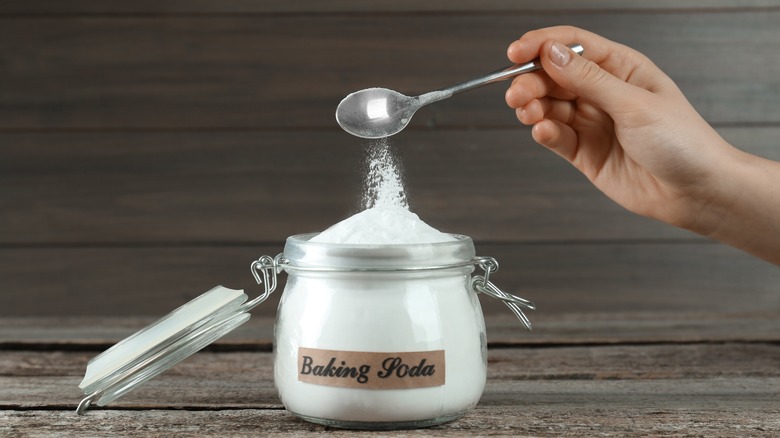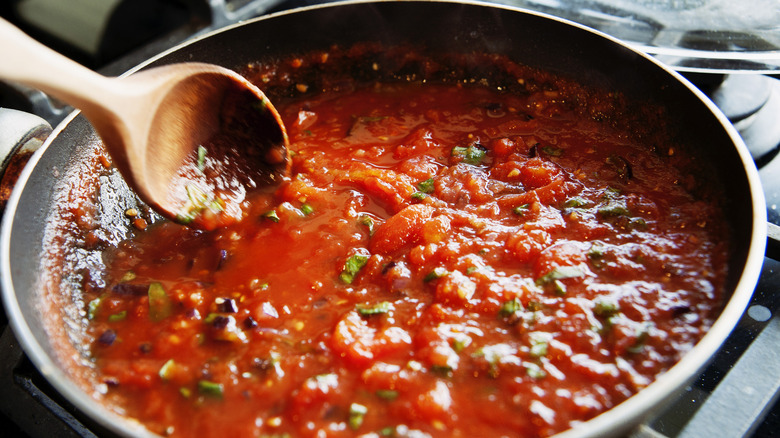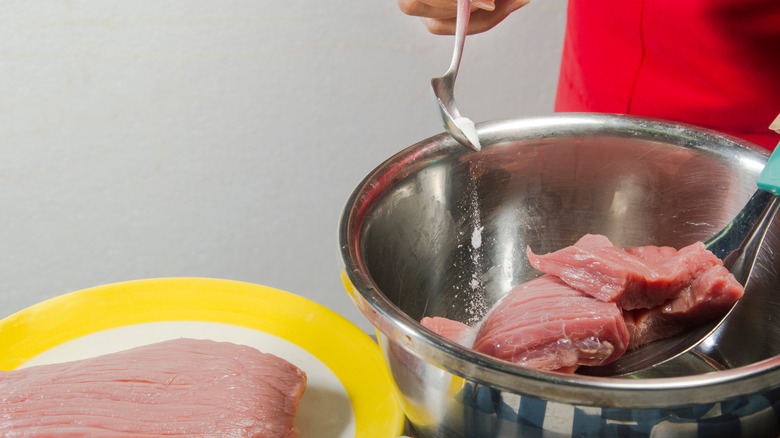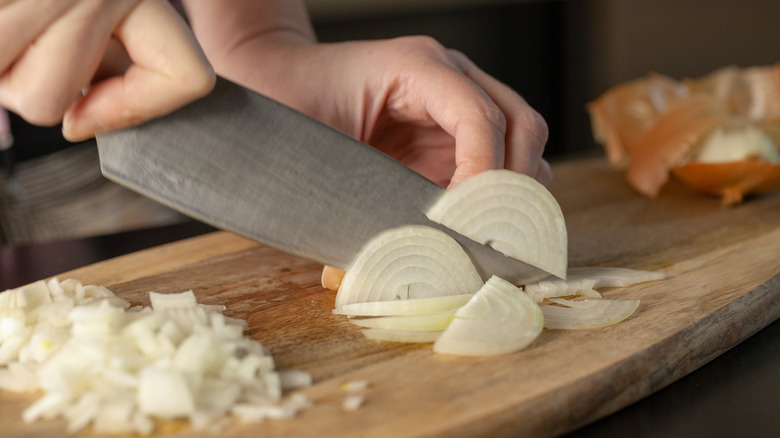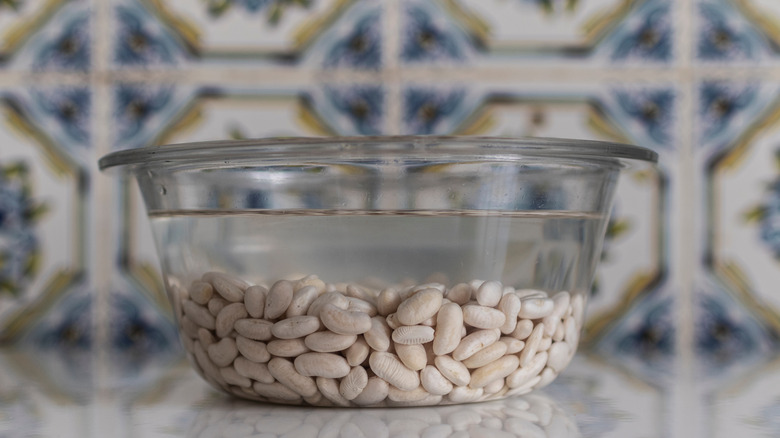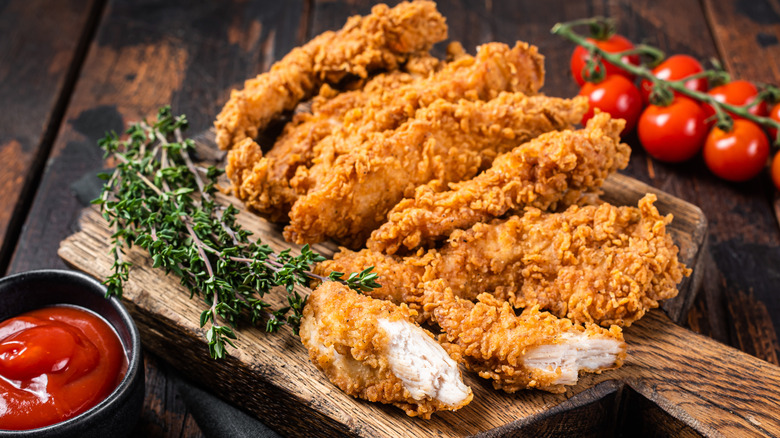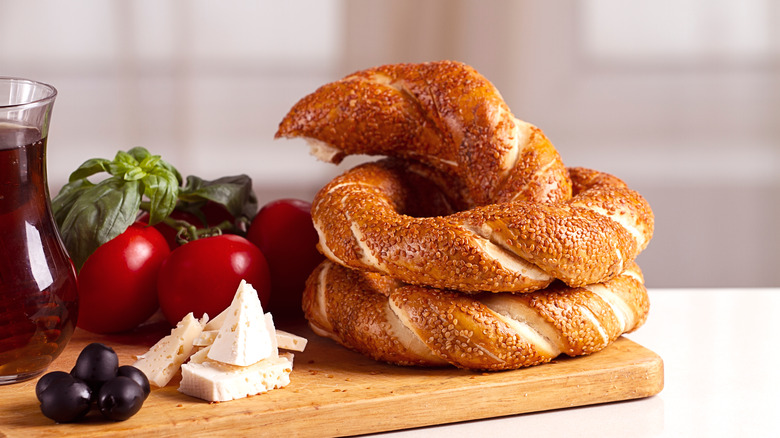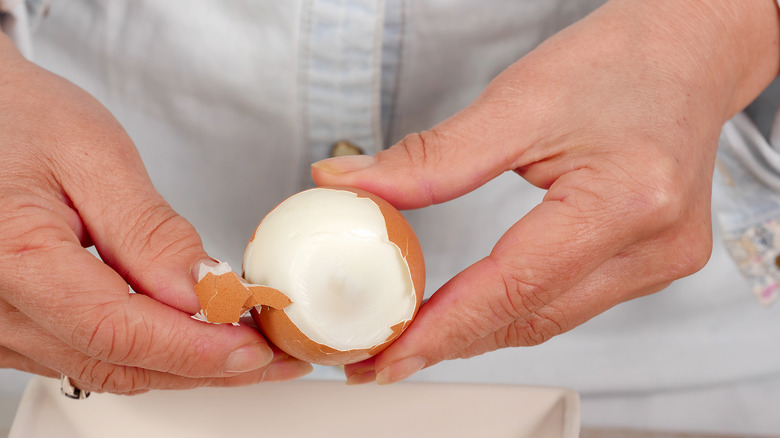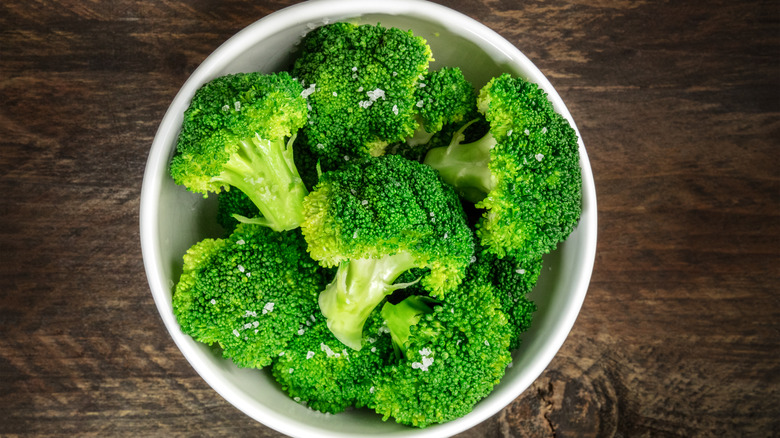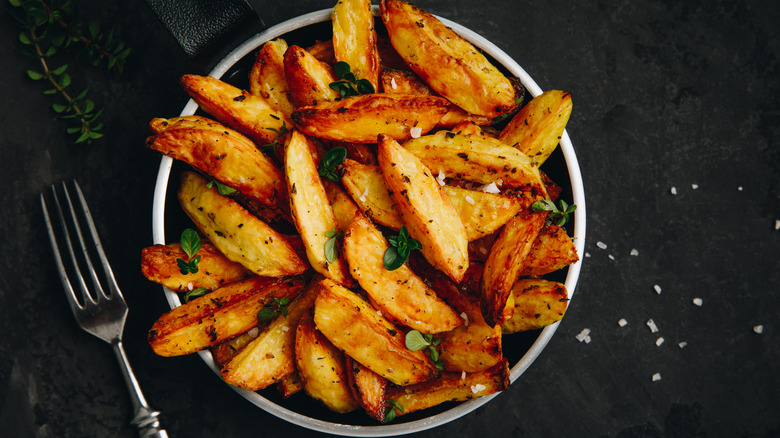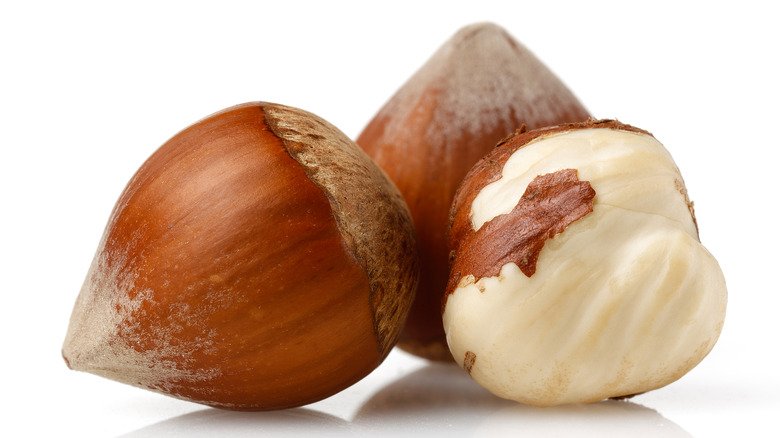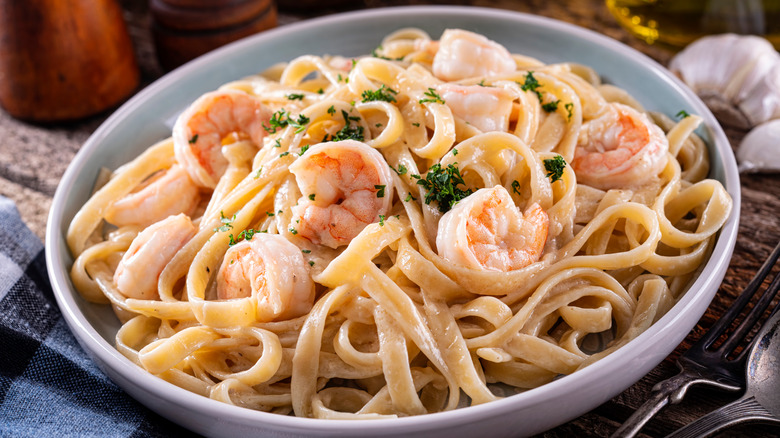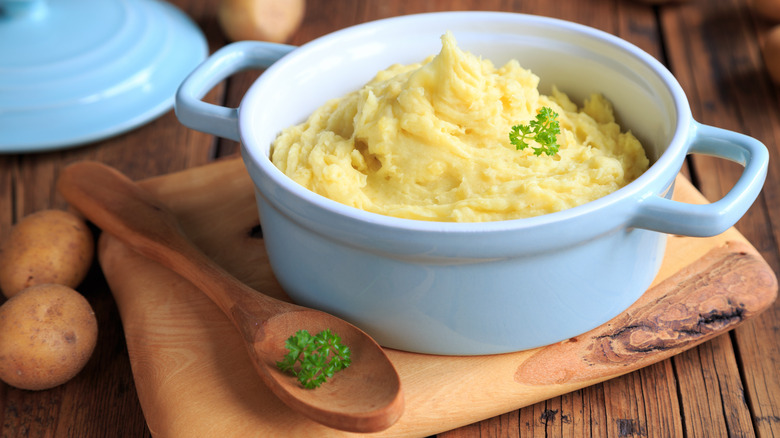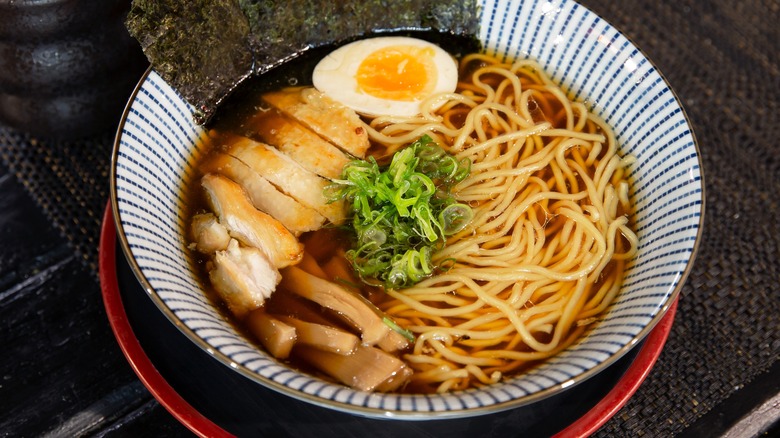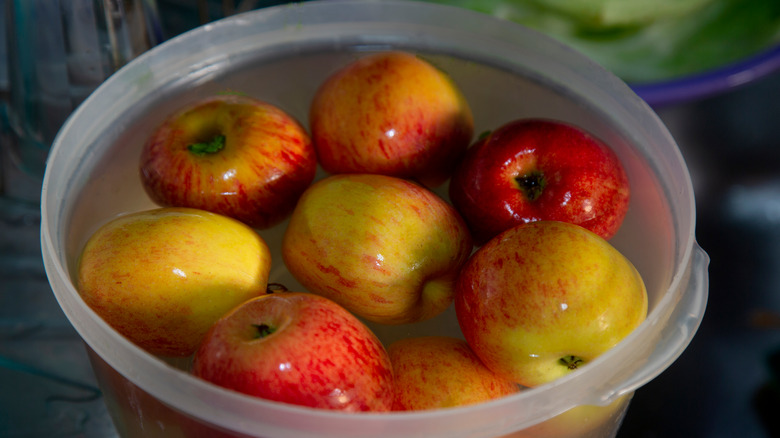14 Baking Soda Cooking Hacks You're Going To Love
These impressive hacks will make you realize you don't actually know every baking soda hack out there. Because believe it or not, the product is not exclusively for baking and cleaning. Yes, there are ways baking soda can make your sink squeaky clean. And, of course, it often belongs in gooey chocolate chip cookie recipes. But it would be an understatement to say that baking soda is a fundamental ingredient for bakers. Because there are numerous other ways to use it in the kitchen.
You can take advantage of baking soda when you're cooking beans, eggs, vegetables, and meat. It can help you with cooking because of where it falls on the potential hydrogen (pH) scale. Using it correctly can make the right ingredients crispy, like comfort foods such as fried chicken and roasted potatoes. Alternatively, it can make certain foods more tender (because who wants to eat tough shrimp or beans)? When you give baking soda a chance to be more than a cleaner or leavening agent, your time in the kitchen will change for the better.
Balance the flavors in tomato sauce
Next time you make spaghetti dinner, remember that you can use a little baking soda in tomato sauce without the use of sugar. Even if you follow a sauce recipe to a tee, it's possible you might still need something to balance the acidity and sweetness levels. Home cooks often throw in a dash of sugar to cure sauce that leans on the sour side, but baking soda works just as well. This hack isn't a coincidence; it works because baking soda is an alkaline substance.
Once you neutralize the bitter notes with the baking soda, the tomatoes' built-in sugars are the star of the show. Something to keep in mind is that you don't want to add too much because baking soda is powerful. Start with a pinch — or ⅛ teaspoon if you like to use specific measurements — and mix it into the sauce. Then, grab a tasting spoon and analyze how the sauce hits your palate. If you feel the baking soda hasn't made much difference, add it in tiny increments until it perfectly stabilizes the sauce's taste.
Tenderize meat
Improving the texture of meat with baking soda is an excellent tip that many chefs use because of its effectiveness. This trick is perfect for when you work with meat that tends to be chewy. First, create a mixture with baking soda and water by using a 1:2 ratio. For instance, if you need to use 16 ounces of water, add 8 ounces of baking soda. Rough chop the meat and immerse it in the liquid; ensure to cover it entirely. Let it soak for up to half an hour before you rinse it and use it.
There is another baking soda hack that not only tenderizes the meat but is also excellent for thickening chili. To try this method, apply a paste to the meat. Use a spoon to mix ¾ teaspoon of baking soda, 1 ½ teaspoon of salt, and 2 tablespoons water until the components are fully incorporated. This amount works best if you use 2 pounds of meat, so you might need to alter it to fit your recipe slightly. Next, slather the mixture onto the meat and allow it to break down the collagen; wait at least 20 minutes and rinse off the baking soda before you add it to the chili. This is a tried-and-true way to make hearty chili with juicy meat.
Improve the taste of onions
Baking soda can come to the rescue when it's time to work with both raw and caramelized onions. Unfortunately, while onions add flavor and texture to your food, sometimes their sharp taste drowns out the taste of other ingredients in your dish. Luckily, onions don't have to overpower your salads and sandwiches with this hack. First, allow the onions to soak in a cup of water for about 10 minutes. Mix 1 tablespoon of baking soda into the fluid until the powder dissolves. Next, place the onions in the bowl, fully submerge them, and allow the baking soda to subdue the tangy taste. Rinse the onions to remove any excess baking soda residue, then use them in wraps, salads, omelets, and more.
When it comes time to caramelize onions, though, it's a whole different ball game. Don't immerse the onions in a solution; add baking soda to your hot pan of veggies. This technique accelerates the caramelization process, which also makes the onions softer. To put into perspective how much to use, for every three onions, ⅛ teaspoon of baking soda is sufficient. This is next level stuff when it comes to caramelized onions.
Soak beans to soften them
Brining beans in baking soda enhances them in multiple ways. And yes, there is a slight difference between brining and soaking; brining involves salt, and soaking does not. Both practices soften the beans, which prevents them from being overly chewy. Mix water with baking soda and salt to make the ultimate brining solution for your beans. Additionally, when you do so, it gives the beans a nudge so they can cook faster, which is arguably the best part.
If you forget to brine your beans or find that they take a relatively long time to cook, you can even add baking soda directly to the pot while they cook. This works as a last-minute solution, which is why we recommend you take the brining route. Whichever way you introduce baking soda to the beans makes them more manageable for the body to digest. So, for folks who suffer uncomfortable indigestion symptoms when they eat beans, baking soda is their saving grace.
Make ultra-crispy chicken
If you're always on the lookout for ways to improve your chicken dishes, this hack is for you. Specifically, the use of baking soda is one way to make super crispy chicken thighs. Although it doesn't have to be exclusively thighs that you use this hack for. Make chicken wings, breasts, or other cuts with this method too. In short, you need to include baking soda when you dredge the raw meat. Some terrific seasonings for chicken include garlic powder, paprika, onion powder, thyme, parsley, and ground mustard. Toss in a couple of pinches of baking soda to complete the mixture.
Finally, cover the chicken with the blend before you cook it. For optimal results, use chicken with the skin on because the skin's pH alters due to the baking soda coming in contact with it. But what does that mean for you? Ultimately, it means the meat's exterior forms a crust and has a deep golden appearance. Also, the interior isn't disturbed, so you still produce juicy meat even when the outside is crispy as ever.
Give breads a golden brown color
Certain types of yeast bread benefit from the use of baking soda. Although many quick breads contain baking soda for leavening, that isn't what we're going for here. Breads that have yeast need no help in the leavening department. Yet, they can use some service in regard to color. Fortunately, baking soda will definitely make your cinnamon rolls brown. This is because its alkaline properties modify the dough just enough to prevent the bread from being pale when it bakes. Mix a bit of it into the dry ingredients of the cinnamon roll dough.
Similarly, baking soda can be the ingredient to making your bagel golden brown too. And again, we can thank baking soda's non-acidic nature for this. However, don't put baking soda in the dough with this type of bread. Instead, use 1 teaspoon of it in the water when you boil the bread. Bagels are nothing without their much-loved crust and soft center, so don't skip out on the baking soda when you make them. While you use the substance differently for cinnamon rolls and bagels, the result is the same: beautifully baked crusts.
Peel hard-boiled eggs easier
When it comes to hard-boiled egg hacks, this trick is one of the best because it's so effortless. If you tend to face challenges when you peel your boiled eggs, adding baking soda to the water can save you. This trick is beneficial when you have to cook fresh eggs compared to old ones (yes, fresh eggs are actually harder to peel; it's not just your imagination).
Since baking soda changes the acidity of the water, it affects the pH of the eggs and the shell's structure. Hence, you can remove the casing in a much smoother fashion. For a whole pot of eggs, include roughly ½ to 1 teaspoon of baking soda in the water. Add it in during the beginning, not while they are already in the midst of cooking. The only downside of this approach is that the more alkaline the water is, the more the sulfur is noticeable in the eggs.
Retain vegetable color
It's undoubtedly a bummer when you cook fresh vegetables and their color ends up extremely dull and dreary. Fortunately, cooked vegetables can stay colorful with this hack, and it's a breeze to follow. When you boil the veggies in water, make sure to throw in some baking soda too. There is no need to measure; just sprinkle a small amount into the pot.
Chlorophyll, which gives vegetables gorgeous green hues, suffers defeat when met with lower pH environments. So, when you add the alkaline substance to the mix, it balances everything out. This hack works with your favorite green vegetables, ranging from broccoli to sugar snap peas. Additionally, even if you follow these steps, it's critical to shock the veggies in an ice bath afterward. Otherwise, there is carry-over cooking, and they lose their vivid color and become an unpleasant texture, which you don't want.
Give potatoes a crunchy outer coating
This hack is for the folks who want super crispy potatoes. Whether you like to roast your potatoes or sauté them, it's advantageous to parboil them beforehand; when you boil them, add baking soda to the water. Specifically, scatter in 1 teaspoon for every gallon of water you use. The properties of the baking soda extract starch from the center of the veggies and bring it toward the outer layer.
This happens thanks to the pH-altering substance, which is why when you boil potatoes in plain water, it doesn't provide the same effect. So, what happens once you cook and drain the potatoes? If you toss them in cooking oil, the fat stays intact during the cooking process. Season them and cook them in the oven or on the stovetop until the exterior forms an impressive crisp casing.
Remove skins from certain food
You've seen how veggies and eggs benefit from being boiled in baking soda water, but how about hazelnuts? Believe it or not, you can use baking soda to remove hazelnut skins. Fill a pot with water, dissolve some baking soda, and bring it to a boil. Cook the hazelnuts in the solution for a few minutes, and then transfer them to an ice bath. Drain the nuts and then use your hands to slide the skins off the hazelnuts easily.
Chickpeas are another food you can easily peel when you use baking soda. For dried garbanzo beans, keep them submerged in baking soda water until the skins become soft from the non-acidic environment. From here, cook them in your favorite way, and the skins become virtually unnoticeable because of their pleasant texture; many of them fall away during the cooking process anyway.
Likewise, for canned chickpeas, use the stovetop or microwave to mix them in warm baking soda water. Use 1 ½ teaspoons of the substance in water when dealing with a standard 14-ounce can of beans. Don't forget to rinse the beans after. Easily and manually separate the skins from the chickpeas because of how detached they become in the mixture.
Take your shrimp meal up a notch
Who would've thought baking soda would be a game-changer when you cook shrimp? No matter how you like shrimp prepared, there are ways to upgrade its texture and prevent it from being rubbery or mushy. This makes shrimp taste better: brining them with baking soda. Let's say you plan to make a pound of shrimp; you only need ¼ teaspoon of baking soda mixed with 1 teaspoon of salt to see results.
Coat the shrimp in the dry brine and allow it to rest for 15 to 30 minutes. Then, of course, you should place them in the refrigerator while you wait. This technique is ideal for stir-fried shrimp, but it is not limited to primarily that cooking method. When you take the extra step to brine the crustaceans, they become pleasantly firm — especially when cooked sous vide. You can also fry or grill the shrimp; it's up to you.
Create fluffy mashed potatoes
You might be familiar with leavening agents and their ability to make foods fluffy. It's super easy to add baking powder to mashed potatoes, and it makes them oh so good! However, the good news is that baking soda works just as well, so there is no need to sweat if you are out of baking powder. It's crucial to remember that although these substances are similar, baking soda is much more forceful.
When you add it to your mashed potatoes, don't add large amounts at a time. Start with minuscule amounts and work your way up to avoid giving the dish a bitter undertone. Additionally, for baking soda to work its magic, include some acidic components (buttermilk mashed potatoes, anyone?). If you don't have buttermilk, make lemon herb mashed potatoes, or throw in some plain Greek yogurt that provides creaminess. Since you use such a small amount of the powder, it might be tricky to distribute it evenly throughout the potatoes. You can always mix the dash of baking soda into another ingredient first, like the milk.
Make ramen noodles out of spaghetti
If you're ever in the mood for ramen but you're in a pickle due to a lack of ingredients, fear not; you can turn spaghetti into ramen. Yes, you guessed it, it involves nifty baking soda. Whether you have classic spaghetti noodles or a similar type like angel hair, you can imitate the texture and display of ramen noodles with an effortless extra step.
When you boil the pot of water for the pasta, stir in baking soda and salt until it disperses throughout. Boil the noodles in the baking soda-infused water; rather than removing them when they are al-dente, allow the pasta to reside in the hot solution for a couple of extra minutes. Of course, upon hearing about this trick, Reddit users had to give it a try. One Redditor posted a photo of their makeshift ramen noodles, with many other users chiming in and asking questions. The user noted how they tried a couple of batches using this hack — and more baking soda resulted in noodles that tasted remarkably similar to ramen. So, baking soda not only changes the appearance of the pasta but the taste, too. What a win!
Remove pesticides from apples
One thing you should always do is rinse your fruit. But sometimes, water isn't enough to eliminate pest-repelling substances companies use on the produce. Unfortunately, unless you buy organic, the apples from the grocery store are commonly tainted with chemicals. Luckily, you'll love to know that baking soda helps remove pesticides on apples. Although it doesn't entirely rid the apples of chemicals altogether, it certainly makes a difference and should be practiced.
Once you have your apples handy, set up a large bowl or container that easily fits them. Dissolve 2 teaspoons of baking soda in a quart of water. Otherwise, use this same ratio and adjust it if you plan to wash many apples at once. Plop the apples into the container and give them about 15 minutes or so to saturate in the liquid. Then, rinse them with running water and allow them to air dry before you refrigerate or use them.
